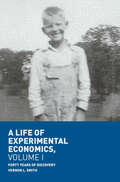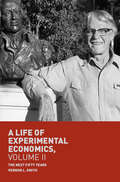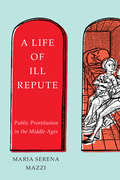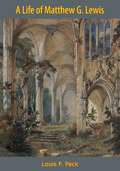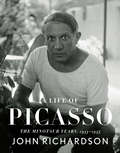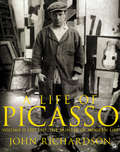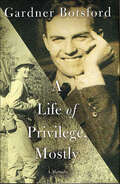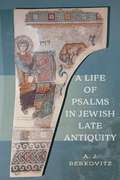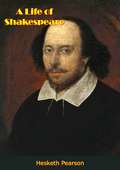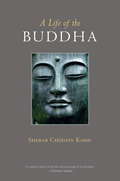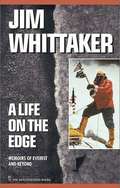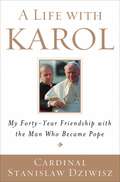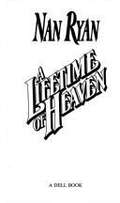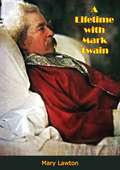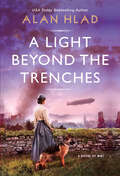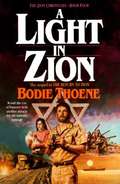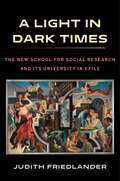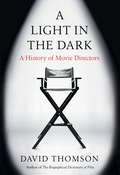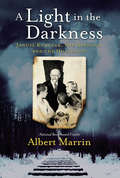- Table View
- List View
A Life of Alexander Campbell (Library of Religious Biography (LRB))
by Douglas A. FosterThe first critical biography of Alexander Campbell, one of the founders of the Stone-Campbell Movement A Life of Alexander Campbell examines the core identity of a gifted and determined reformer to whom millions of Christians around the globe today owe much of their identity—whether they know it or not. Douglas Foster assesses principal parts of Campbell&’s life and thought to discover his significance for American Christianity and the worldwide movement that emerged from his work. He examines Campbell&’s formation in Ireland, his creation and execution of a reform of Christianity beginning in America, and his despair at the destruction of his vision by the American Civil War. A Life of Alexander Campbell shows why this important but sometimes misunderstood and neglected figure belongs at the heart of the American religious story.
A Life of Alexander Campbell (Library of Religious Biography (LRB))
by Douglas A. FosterThe first critical biography of Alexander Campbell, one of the founders of the Stone-Campbell Movement A Life of Alexander Campbell examines the core identity of a gifted and determined reformer to whom millions of Christians around the globe today owe much of their identity—whether they know it or not. Douglas Foster assesses principal parts of Campbell&’s life and thought to discover his significance for American Christianity and the worldwide movement that emerged from his work. He examines Campbell&’s formation in Ireland, his creation and execution of a reform of Christianity beginning in America, and his despair at the destruction of his vision by the American Civil War. A Life of Alexander Campbell shows why this important but sometimes misunderstood and neglected figure belongs at the heart of the American religious story.
A Life of Experimental Economics, Volume I: Forty Years of Discovery
by Vernon L. SmithThis book provides an intimate history of Nobel Laureate Vernon Smith’s early life, combining elements of biography, history, economics and philosophy to show how crucial incidents early in his life provided the necessary framework for his research into experimental economics. Smith takes the reader from his family roots on the railroads and oil fields of Middle America to his early life on a farm in Depression-wracked Kansas. A mediocre student in high school, Smith attended Friends University, on Wichita’s west side, where an intense study of mathematics, physics, chemistry, and astronomy enabled him to pass the examinations to enter Caltech and study under luminary scientists like Linus Pauling. Eventually Smith discovered economics and pursued graduate study in the field at University of Kansas and Harvard. This volume ends with his Camelot years at Purdue, where he began his famous work in experimental economics, nurturing his research into an unlikely new field of economics.
A Life of Experimental Economics, Volume II: The Next Fifty Years
by Vernon L. SmithThis sequel to A Life of Experimental Economics, Volume I, continues the intimate history of Vernon Smith’s personal and professional maturation after a dozen years at Purdue. The scene now shifts to twenty-six transformative years at the University of Arizona, then to George Mason University, and his recognition by the Nobel Prize Committee in 2002. The book ends with his most recent decade at Chapman University. At Arizona Vernon and his students studied asset trading markets and learned how wrong it had been to suppose that price bubbles could not occur where markets were full-information transparent. Their work in computerization of the lab facilitated very complex supply and demand experiments in natural gas pipeline, communication and electricity markets that paved the way for implementing, through decentralized market processes, the liberalization of industries traditionally believed to be “natural” monopolies. The “Smart Computer Assisted Market” was born. Smith’s move to George Mason University greatly facilitated government and industry work in tandem with various public and private entities, whereas his relocation to Chapman University coincided with the Great Recession, whose similarity with the Depression was evident in his research. There he integrated two fundamental kinds of markets with laboratory experiments: Consumer non-durables, the supply and demand for which was stable in the lab and in the economy, and durable assets whose bubble tendencies made them unstable in the lab as well as in the economy—witness the great housing-mortgage market bubble run-up of 1997-2007. This book’s conversational style and emphasis on the backstory of published research accomplishments allows readers an exclusive peak into how and why economists pursue their work. It’s a must-read for those interested in experimental economics, the housing crisis, and economic history.
A Life of Ill Repute: Public Prostitution in the Middle Ages
by Maria MazziProstitution is often called the oldest profession in the world. Even in the Middle Ages, people believed that there would always be women willing to use their bodies for profit. But who were these women who offered themselves up to men? In A Life of Ill Repute Maria Serena Mazzi traces and reconstructs prostitution in the early fourteenth century, describing how in medieval European society women - often extremely poor and overwhelmed by debt, or victims either of predatory men full of duplicitous intentions or simply of rape - were traded as commodities. Prostitutes, according to Mazzi, were despised and condemned but considered necessary in an ambiguous and contradictory society that tolerated their sexual exploitation to safeguard the virtue of honest women and counter the vice of homosexuality, while allowing men to vent their own impulses. The theory of the lesser evil - encouraged by both the church and the state - is the grounds on which prostitution flourished in medieval Europe. In the Middle Ages prostitution was censured and considered disgraceful, but at the same time it was deemed inevitable and even necessary. A Life of Ill Repute uncovers the hypocrisy and speciousness of ecclesiastical, political, and social arguments for the justification of the existence of public prostitution.
A Life of Matthew G. Lewis
by Louis F. PeckMatthew Lewis (17775-1818), author of The Monk—one of the most famous of gothic novels—is attracting increasing attention for his own talent and his pre-eminence in the gothic school. The gothic mode, aside from its intrinsic interest, is important because of its distinct influence in British, continental, and American literature. Yet a full-length biography of Lewis has not appeared since 1839.For the nonspecialist seeking an introduction to Romanticism and the Regency, Lewis is a valuable man to know, with his varied literary interests—poetry, the novel, drama—and his wide acquaintance: royalty, the peerage, literary celebrities like Byron, Scott, Shelley, Sheridan, and the theatrical world. As a writer he showed uncanny anticipation of popular literary trends and a talent for the spectacular. This new biography, based on information which has appeared since 1839 and on new material, presents the whole man, not a selection of eccentricities. It includes treatment of all his works and a section of newly edited correspondence.
A Life of Picasso IV: 1933-1943 (A Life of Picasso #4)
by John RichardsonThe beautifully illustrated fourth volume of Picasso&’s life—set in France and Spain during the Spanish Civil War and World War II—covers friendships with the surrealist painters; artistic inspiration around Guernica and the Minotaur; and his muses Marie-Thérèse, Dora Maar, and Françoise Gilot; and much more.Including 271 stunning illustrations and drawing on original and exhaustive research from interviews and never-before-seen material in the Picasso family archives, this book opens with a visit by the Hungarian-French photographer Brassaï to Picasso&’s chateau in Normandy, Boisgeloup, where he would take his iconic photographs of the celebrated plaster busts of Marie-Thérèse, Picasso&’s mistress and muse. Picasso was contributing to André Breton&’s Minotaur magazine and he was also spending more time with the likes of Man Ray, Salvador Dalí, Lee Miller, and the poet Paul Éluard, in Paris as well as in the south of France. It was during this time that Picasso began writing surrealist poetry and became obsessed with the image of himself as the mythic Minotaur—head of a bull, body of a man—and created his most famous etching, Minotauromachie. Richardson shows us the artist is as prolific as ever, painting Marie-Thérèse, but also painting the surrealist photographer Dora Maar who has become a muse, a collaborator and more. In April 1937, the bombing of the town of Guernica during the Spanish Civil War inspires Picasso&’s vast masterwork of the same name, which he paints in just a few weeks for the Spanish Pavilion at the Paris World&’s Fair. When the Nazis occupy Paris in 1940, Picasso chooses to remain in the city despite the threat that his art would be confiscated. In 1943, Picasso meets Françoise Gilot who would replace Dora, and as Richardson writes, &“rejuvenate his psyche, reawaken his imagery and inspire a brilliant sequence of paintings.&” As always, Richardson tells Picasso&’s story through his work during this period, analyzing how it shows what the artist was feeling and thinking. His fascinating and accessible narrative immerses us in one of the most exciting moments in twentieth century cultural history, and brings to a close the definitive and critically acclaimed account of one of the world&’s most celebrated artists.
A Life of Picasso Volume II: 1907 1917: The Painter of Modern Life (Life of Picasso #2)
by John RichardsonJohn Richardson draws on the same combination of lively writing, critical astuteness, exhaustive research, and personal experience which made a bestseller out of the first volume and vividly recreates the artist's life and work during the crucial decade of 1907-17 - a period during which Pablo Picasso and Georges Braque invented Cubism and to that extent engendered modernism. Richardson has had unique access to untapped sources and unpublished material. By harnessing biography to art history, he has managed to crack the code of cubism more successfully than any of his predecessors. And by bringing a fresh light to bear on the artist's often too sensationalised private life, he has succeeded in coming up with a totally new view of this paradoxical man of his paradoxical work. Never before has Picasso's prodigious technique, his incisive vision and not least his sardonic humour been analysed with such clarity.
A Life of Privilege, Mostly: A Memoir
by Gardner BotsfordGardner Botsford's A Life of Privilege tells the fascinating and humorous story of his WWII experiences, from his assignment to the infantry due to a paperwork error to a fearful trans-Atlantic crossing on the Queen Mary, to landing under heavy fire on Omaha Beach and the Liberation of Paris. After the war, he began a distinguished literary career as a long-time editor at the New Yorker, and chronicles the magazine's rise and influence on postwar American culture with wit and grace.
A Life of Psalms in Jewish Late Antiquity (Jewish Culture and Contexts)
by AJ BerkovitzThe Bible shaped nearly every aspect of Jewish life in the ancient world, from activities as obvious as attending synagogue to those which have lost their scriptural resonance in modernity, such as drinking water and uttering one’s last words. And within a scriptural universe, no work exerted more force than the Psalter, the most cherished text among all the books of the Hebrew Bible.A Life of Psalms in Jewish Late Antiquity clarifies the world of late ancient Judaism through the versatile and powerful lens of the Psalter. It asks a simple set of questions: Where did late ancient Jews encounter the Psalms? How did they engage with the work? And what meanings did they produce? A. J. Berkovitz answers these queries by reconstructing and contextualizing a diverse set of religious practices performed with and on the Psalter, such as handling a physical copy, reading from it, interpreting it exegetically, singing it as liturgy, invoking it as magic and reciting it as an act of piety. His book draws from and contributes to the fields of ancient Judaism, biblical reception, book history and the history of reading.
A Life of Shakespeare
by Hesketh Pearson‘You are a genuine soaker in Shakespeare, and have not read him as a task. You have him by heart.’—Bernard Shaw wrote in a letter to Hesketh Pearson.Before he became a well-known biographer, Hesketh Pearson was an actor. Few facts are known about Shakespeare, but with an actor’s eye and a supreme self-confidence Pearson has drawn a recognisable portrait of Shakespeare the man—even telling us the colour of his hair and of his predilection for black-haired women. The plays and poems are assessed in the search to discover and build up a picture of Shakespeare’s character. Pearson has included an anthology of his favourite lines and passages.
A Life of Sir John Eldon Gorst: Disraeli's Awkward Disciple (British Politics and Society)
by Archie HunterThis is the first book to tell the story of on eof the most contentious figures in Victorian and Edwardian politics: that of the independent-minded and exceptionally able Conservative politician, Sir John Eldon Gorst.
A Life of Worry: Politics, Mental Health, and Vietnam’s Age of Anxiety (Ethnographic Studies in Subjectivity #17)
by Allen L TranA free ebook version of this title is available through Luminos, University of California Press’s Open Access publishing program. Visit www.luminosoa.org to learn more. Who, what, and how we fear reflects who we are. In less than half a century, people in Vietnam have gone from fearing bombing raids, political persecution, and starvation to worrying about decisions over the best career path or cell phone plan. This shift in the landscape of people’s anxieties is the result of economic policies that made Vietnam the second-fastest-growing economy in the world and a triumph of late capitalist development. Yet as much as people marvel at the speed of progress, all this change can be difficult to handle. A Life of Worry unpacks an ethnographic puzzle. What accounts for the simultaneous rise of economic prosperity and anxiety among Ho Chi Minh City’s middle class? The social context of anxiety in Vietnam is layered within the development of advanced capitalism, the history of the medical and psychological sciences, and new ways of drawing the line between self and society. At a time when people around the world are turning to the pharmaceutical and wellness industries to soothe their troubled minds, it is worth considering the social and political dynamics that make the promises of these industries so appealing.
A Life of the Buddha
by Sherab Chodzin KohnThe story of the Buddha and his awakening is more than an account of the birth of a religious tradition: it is also one of the great archetypal tales of the spiritual quest, colorful in its many details and thrilling in its depiction of the world transformed by an enlightened human being. Sherab Chödzin Kohn's retelling of the Buddha's life is both readable and historically informed, and presents the Buddha's teachings along with the events of his past lives to final nirvana. Library Journal called it "a splendid combination of biography and instruction." This new edition of the book previously entitled The Awakened One has been updated to include a short history of Buddhism as well as a selection of resources for further reading.
A Life on the Edge: Memoirs of Everest and Beyond
by Jim WhittakerJim Whittaker's achievement on Everest and his many successes before and after are the natural outcome of a life driven by a passion for outdoor adventure combined with strong leadership qualities and a commitment to making a difference. In A Life on the Edge, readers will discover a true hero-someone who tells his story not to boast or preach, but to share his love of the environment and outdoor adventure and to inspire others to seek challenges in their own lives.
A Life with Karol
by Cardinal Stanislaw DziwiszThis intimate, affectionate portrait of Pope John Paul II by his longtime secretary and confidant reveals fascinating new details about the opinions, hopes, fears, and dramatic life of this public man. "I had accompanied him for almost forty years: twelve in Kraków and then twenty-seven in Rome. I was always with him, always at his side. Now, in the moment of death, he'd gone on alone...And now? Who is accompanying him on the other side?"- From A Life with Karol Cardinal Stanislaw Dziwisz worked side by side with Pope John Paul II for almost forty years, enjoying unique access to both the public and private man. In A life with Karol, he provides a close-up glimpse into the Pope's life and the critical events of his papacy. Dziwisz was sitting next to the Pope during the assassination attempt in 1981. He recounts the Pope's reaction to 9/11, describing his thoughts and feelings on that day. And the Cardinal's moving description of the Pope's haunting memories of World War II uncovers the roots of the pontiff's intense opposition to George W. Bush's war on Iraq.The two men shared moments of fun and spontaneity as well. Dziwisz writes about the times the Pope would slip out of the Vatican, wearing a Panama hat, to stroll the streets of Rome, and he describes the clandestine ski and hiking trips the pair made to escape the Vatican. His firsthand account of the Pope's last years also reveals that John Paul II considered resigning. These stories and others lend added poignancy to Dziwisz's extraordinary portrayal of the Pope's courage and calmness during his final illness.
A Lifetime in Gatlinburg: Martha Cole Whaley Remembers (American Heritage)
by Marie MaddoxToday, Gatlinburg is an idyllic mountain resort. But the Sugarlands Valley in the 1910s couldn't have been more different. Martha Cole Whaley began her life on the outskirts of the city and has witnessed firsthand the joy and struggle of more than one hundred years in the area. Her rich experiences include what it was like to eat onion tops for an after-school snack, bathe in a washtub behind the stove and see a zipper for the first time on the boots of the mailman. Join author Marie Maddox as she captures an amazing century of Martha's life in Gatlinburg through stories, interviews and even a few of her favorite recipes from now and then.
A Lifetime with Mark Twain: The Memories of Katy Leary, for Thirty Years His Faithful and Devoted Servant (American Literature Ser. #No. 49)
by Mary Lawton Kate LearyThis book, which was first published in 1925, is a transcription of an informal account by Katy Leary of her thirty years’ service to the household of Samuel Langhorne Clemens (1835-1910), the 19th century American writer, humourist, entrepreneur, publisher and lecturer, better known by his pen name Mark Twain, who became world-famous for novels such as Adventures of Tom Sawyer (1876) and its sequel, Adventures of Huckleberry Finn (1885).It was Mark Twain who suggested that the faithful Katy tell the world all she knew about him. Her reminiscences were locked away in her memory until Miss Mary Lawton, who had known Mr. and Mrs. Clemens for many years, persuaded Katy to reveal them. Katy Leary began to talk and, pencil in hand, Miss Lawton recorded while the old servant poured forth the inimitable words in which she related many a chapter as yet unknown to those outside the family circle.A fascinating read.
A Light Among Shadows
by Tamela Hancock MurrayABIGAIL'S FUTURE LOOKS BLEAK. Although a member of Britain's aristocracy Abigail has led a sheltered life in her father's manor house. Then, she discovers the arranged marriage her father has planned.
A Light Beyond the Trenches: A Fascinating Historical Novel of WW1
by Alan HladFrom the USA Today bestselling author of Churchill&’s Secret Messenger comes a WWI novel based on little-known history, as four very different lives intertwine across Europe from Germany to France—a German Red Cross nurse, a Jewish pianist blinded on the battlefield, a soldier tortured by deadly secrets of his own, and his tormented French mistress. This life-affirming tale of heroism and resilience will stay with you long after turning the final page. By April 1916, the fervor that accompanied war&’s outbreak has faded. In its place is a grim reality. Throughout Germany, essentials are rationed. Hope, too, is in short supply. Anna Zeller, whose fiancé, Bruno, is fighting on the western front, works as a nurse at an overcrowded hospital in Oldenburg, trying to comfort men broken in body and spirit. But during a visit from Dr. Stalling, the director of the Red Cross Ambulance Dogs Association, she witnesses a rare spark of optimism: as a German shepherd guides a battle-blinded soldier over a garden path, Dr. Stalling is inspired with an idea—to train dogs as companions for sightless veterans. Anna convinces Dr. Stalling to let her work at his new guide dog training school. Some of the dogs that arrive are themselves veterans of war, including Nia, a German shepherd with trench-damaged paws. Anna brings the ailing Nia home and secretly tends and trains her, convinced she may yet be the perfect guide for the right soldier. In Max Benesch, a Jewish soldier blinded by chlorine gas at the front, Nia finds her person. War has taken Max&’s sight, his fiancée, and his hopes of being a composer. Yet despite all he&’s given for his country, the tide of anti-Semitism at home is rising, and Max encounters it first-hand in one of the school&’s trainers, who is determined to make Max fail. Still, through Anna&’s prompting, he rediscovers his passion for music. But as Anna discovers more about the conflict&’s escalating brutality—and Bruno&’s role in it—she realizes how impossible it will be for any of them to escape the war unscathed . . .
A Light In Zion (The Zion Chronicles, Book #4)
by Bodie Thoene Brock ThoeneBook Jacket: The fourth book in THE ZION CHRONICLES, A Light in Zion opens in April 1948, only six weeks before the final evacuation of the British from Israel. The dream for the rebirth of the Jewish nation now appears doomed to extinction. The British have almost totally withdrawn from any interference between the battles of the nearly unarmed Jews and the Arab soldiers of Haj Amin Husseini. The eve of Passover finds the Jewish sector of Jerusalem being starved into submission by an Arab siege. While Moshe and his Jewish troops risk their lives to open the Arab-held pass of Bab el Wad for a food convoy to save their people, David and Ellie search the Mediterranean for a freighter loaded with weapons for the Muslim Jihad and the bands of Arab soldiers who still vow to drive the Jews into the sea. And Rachel's mother-heart yearns over her fever-ravaged infant...
A Light in Dark Times: The New School for Social Research and Its University in Exile
by Judith FriedlanderThe New School for Social Research opened in 1919 as an act of protest. Founded in the name of academic freedom, it quickly emerged as a pioneer in adult education—providing what its first president, Alvin Johnson, liked to call “the continuing education of the educated.” By the mid-1920s, the New School had become the place to go to hear leading figures lecture on politics and the arts and recent developments in new fields of inquiry, such as anthropology and psychoanalysis. Then in 1933, after Hitler rose to power, Johnson created the University in Exile within the New School. Welcoming nearly two hundred refugees, Johnson, together with these exiled scholars, defiantly maintained the great traditions of Europe’s imperiled universities.Judith Friedlander reconstructs the history of the New School in the context of ongoing debates over academic freedom and the role of education in liberal democracies. Against the backdrop of World War I and the first red scare, the rise of fascism and McCarthyism, the student uprisings during the Vietnam War and the downfall of communism in Eastern Europe, Friedlander tells a dramatic story of intellectual, political, and financial struggle through illuminating sketches of internationally renowned scholars and artists. These include, among others, Charles A. Beard, John Dewey, José Clemente Orozco, Robert Heilbroner, Hannah Arendt, and Ágnes Heller. Featured prominently as well are New School students, trustees, and academic leaders. As the New School prepares to celebrate its one-hundredth anniversary, A Light in Dark Times offers a timely reflection on the legacy of this unique institution, which has boldly defended dissident intellectuals and artists in the United States and overseas.
A Light in the Dark: A History of Movie Directors
by David ThomsonFrom the celebrated film critic and author of The Biographical Dictionary of Film--an essential work on the preeminent, indispensable movie directors and the ways in which their work has forged, and continues to forge, the landscape of modern film.Directors operate behind the scenes, managing actors, establishing a cohesive creative vision, at times literally guiding our eyes with the eye of the camera. But we are often so dazzled by the visions on-screen that it is easy to forget the individual who is off-screen orchestrating the entire production--to say nothing of their having marshaled a script, a studio, and other people's money. David Thomson, in his usual brilliantly insightful way, shines a light on the visionary directors who have shaped modern cinema and, through their work, studies the very nature of film direction. With his customary candor about his own delights and disappointments, Thomson analyzes both landmark works and forgotten films from classic directors such as Orson Welles, Alfred Hitchcock, Jean Renoir, and Jean-Luc Godard, as well as contemporary powerhouses such as Jane Campion, Spike Lee, and Quentin Tarantino. He shrewdly interrogates their professional legacies and influence in the industry, while simultaneously assessing the critical impact of an artist's personal life on his or her work. He explores the male directors' dominance of the past, and describes how diversity can change the landscape. Judicious, vivid, and witty, A Light in the Dark is yet another required Thomson text for every movie lover's shelf.
A Light in the Darkness: Janusz Korczak, His Orphans, and the Holocaust
by Albert MarrinFrom National Book Award Finalist Albert Marrin comes the moving story of Janusz Korczak, the heroic Polish Jewish doctor who devoted his life to children, perishing with them in the Holocaust. <P><P>Janusz Korczak was more than a good doctor. He was a hero. The Dr. Spock of his day, he established orphanages run on his principle of honoring children and shared his ideas with the public in books and on the radio. He famously said that "children are not the people of tomorrow, but people today." Korczak was a man ahead of his time, whose work ultimately became the basis for the U.N. Declaration of the Rights of the Child. <P><P>Korczak was also a Polish Jew on the eve of World War II. He turned down multiple opportunities for escape, standing by the children in his orphanage as they became confined to the Warsaw Ghetto. Dressing them in their Sabbath finest, he led their march to the trains and ultimately perished with his children in Treblinka. <P><P>But this book is much more than a biography. In it, renowned nonfiction master Albert Marrin examines not just Janusz Korczak's life but his ideology of children: that children are valuable in and of themselves, as individuals. He contrasts this with Adolf Hitler's life and his ideology of children: that children are nothing more than tools of the state. <P><P>And throughout, Marrin draws readers into the Warsaw Ghetto. What it was like. How it was run. How Jews within and Poles without responded. Who worked to save lives and who tried to enrich themselves on other people's suffering. And how one man came to represent the conscience and the soul of humanity. <P><P>Filled with black-and-white photographs, this is an unforgettable portrait of a man whose compassion in even the darkest hours reminds us what is possible.

